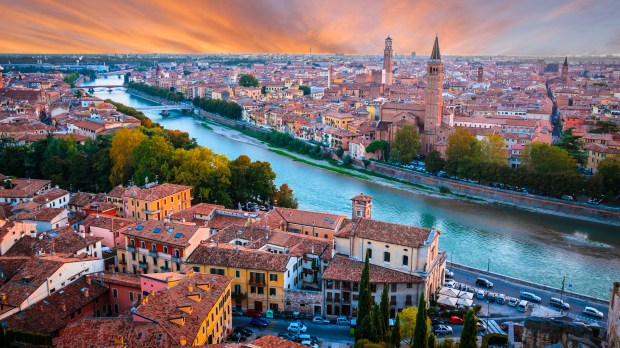This past Saturday, May 18, Pope Francis paid a visit to “fair Verona,” as Shakespeare called it. The city may be less famous than Venice, the destination of the Pope’s previous trip outside Rome. Still, the city has been the site of at least two important historical events, plus one particularly famous story that is fictional.
Romeo Ghibelline and Juliet Guelph?
Shakespeare’s famous drama is linked to the great conflict between the Guelphs, supporters of the pope, and the Ghibellines, supporters of the emperor, between the 12th and 14th centuries. Verona was the scene of violent clashes between these factions, particularly after the city was taken by the Ghibelline Ezzelino the Fierce in 1225.
Fiction often surpasses history, as the Cappelletti and Montecchi families — anglicized by Shakespeare into Capulet and Montague — never clashed in Verona. But a very violent struggle between family clans did indeed rage during this period, to the point of reaching the inspired ears of the Bard of Avon.
A forgotten pope and council
Ubaldo Allucingoli, who became Pope Lucius III in 1185, is not the best-known pontiff in history. After his election, he clashed with Emperor Frederick Barbarossa over a dispute over territories and the revenues attached to them. In 1184, he traveled to Verona to hold talks with the emperor, but to no avail.
That same year, he took advantage of his presence in the city to convene a council, now widely forgotten, which resulted in the condemnation of several heresies, including those of the Cathars, Waldensians, and Patarines. The meeting concluded with the bull Ad abolendam, which instituted the inquisition at episcopal level.
During this period, Rome was troubled by violent conflicts, and Lucius III decided not to return. He often ruled from Verona, where he died in 1885. His tomb and remains are still in the city’s cathedral.
The Pope and Atilla the Hun
Many years before, in the 5th century, the city hosted a meeting of two giants. The city of Verona, thanks to the work of its holy bishop Zeno, had recently converted to Christianity at the time of the fall of the Western Roman Empire. The city found itself in the path of the barbarian invasions including the capture of the city by the Goths in 402.
In 452, the armies of Attila, warlord of the Huns, landed in what is now Veneto. To repel the “Scourge of God,” who had announced his intention to take control of Italy, Pope Leo I the Great presented himself unarmed but with a crucifix at Salionze, near Verona.
Attila, who was Romanized, received his host with dignity and, after a secret meeting, renounced his ambitions for the peninsula. A famous depiction of this historic meeting, by the painter Raphael, can be seen today in the Vatican Palace.



